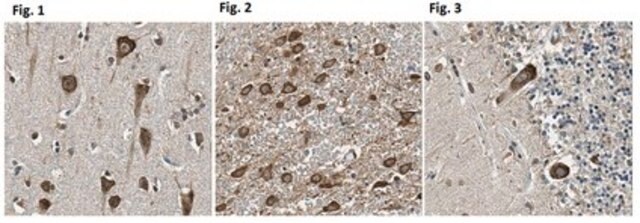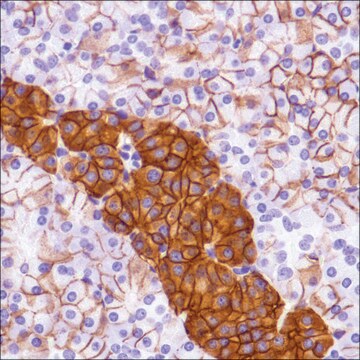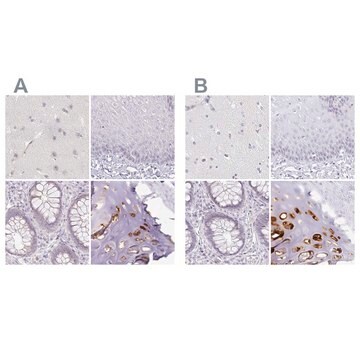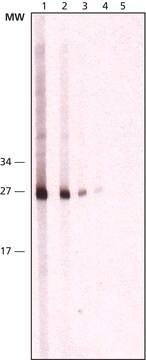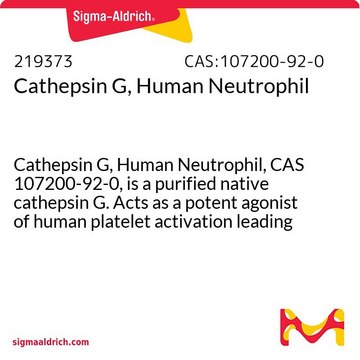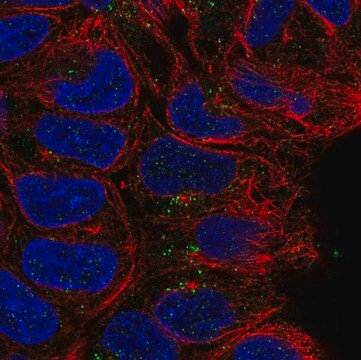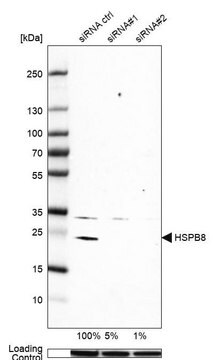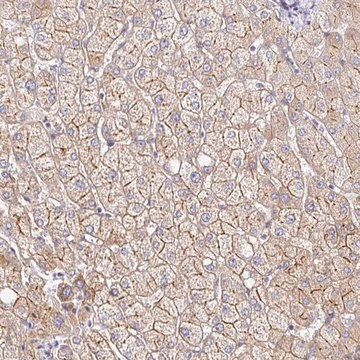推荐产品
生物源
mouse
共軛
unconjugated
抗體表格
purified immunoglobulin
抗體產品種類
primary antibodies
無性繁殖
2F1, monoclonal
形狀
buffered aqueous solution
物種活性
human
技術
indirect ELISA: suitable
western blot: 1-5 μg/mL
同型
IgG2aκ
GenBank登錄號
UniProt登錄號
運輸包裝
dry ice
儲存溫度
−20°C
目標翻譯後修改
unmodified
基因資訊
human ... CTSK(1513)
一般說明
The protein encoded by this gene is a lysosomal cysteine proteinase involved in bone remodeling and resorption. This protein, which is a member of the peptidase C1 protein family, is predominantly expressed in osteoclasts. However, the encoded protein is also expressed in a significant fraction of human breast cancers, where it could contribute to tumor invasiveness. Mutations in this gene are the cause of pycnodysostosis, an autosomal recessive disease characterized by osteosclerosis and short stature. This gene may be subject to RNA editing. (provided by RefSeq)
免疫原
CTSK (AAH16058, 220 a.a. ~ 329 a.a) partial recombinant protein with GST tag. MW of the GST tag alone is 26 KDa.
Sequence
KCRGYREIPEGNEKALKRAVARVGPVSVAIDASLTSFQFYSKGVYYDESCNSDNLNHAVLAVGYGIQKGNKHWIIKNSWGENWGNKGYILMARNKNNACGIANLASFPKM
Sequence
KCRGYREIPEGNEKALKRAVARVGPVSVAIDASLTSFQFYSKGVYYDESCNSDNLNHAVLAVGYGIQKGNKHWIIKNSWGENWGNKGYILMARNKNNACGIANLASFPKM
生化/生理作用
Cathepsin K has a role in bone resorption and remodeling. It has a triple helical collagen hydrolase activity. Mutations in the gene encoding this protein have been linked to pycnodysostosis.
外觀
Solution in phosphate buffered saline, pH 7.4
法律資訊
GenBank is a registered trademark of United States Department of Health and Human Services
免責聲明
Unless otherwise stated in our catalog or other company documentation accompanying the product(s), our products are intended for research use only and are not to be used for any other purpose, which includes but is not limited to, unauthorized commercial uses, in vitro diagnostic uses, ex vivo or in vivo therapeutic uses or any type of consumption or application to humans or animals.
未找到合适的产品?
试试我们的产品选型工具.
儲存類別代碼
10 - Combustible liquids
閃點(°F)
Not applicable
閃點(°C)
Not applicable
個人防護裝備
Eyeshields, Gloves, multi-purpose combination respirator cartridge (US)
Adeleke H Aguda et al.
Proceedings of the National Academy of Sciences of the United States of America, 111(49), 17474-17479 (2014-11-26)
Cathepsin K is the major collagenolytic protease in bone that facilitates physiological as well as pathological bone degradation. Despite its key role in bone remodeling and for being a highly sought-after drug target for the treatment of osteoporosis, the mechanism
Vito Turk et al.
Biochimica et biophysica acta, 1824(1), 68-88 (2011-10-26)
It is more than 50 years since the lysosome was discovered. Since then its hydrolytic machinery, including proteases and other hydrolases, has been fairly well identified and characterized. Among these are the cysteine cathepsins, members of the family of papain-like
Guangxian Zhao et al.
PloS one, 10(8), e0136093-e0136093 (2015-08-25)
Cysteinyl cathepsin K (CatK) is one of the most potent mammalian collagenases involved in cardiovascular disease. Here, we investigated the clinical predictive value of serum CatK levels in patients with chronic heart failure (CHF). We examined 134 patients with CHF
Joaquín Bobillo Lobato et al.
Medicina clinica, 145(7), 281-287 (2015-02-11)
Gaucher disease is an inherited disorder caused by deficit of acid β-glucocerebrosidase, responsible for the degradation of glucosylceramide to ceramide and glucose. Although the disorder is primarily hematologic, bone is the second most commonly affected structure. Cathepsin K (CATK) is
Jaime Toral-López et al.
Journal of investigative medicine : the official publication of the American Federation for Clinical Research, 59(2), 277-280 (2010-11-26)
Pycnodysostosis, an autosomal recessive skeletal dysplasia, is characterized by short stature, osteosclerosis, delayed cranial suture closure, hypoplastic mandible, acro-osteolysis, hypoplastic clavicle, and dental anomalies. The disorder is caused by CTSK gene defects, a gene localized on 1q21. To describe the
我们的科学家团队拥有各种研究领域经验,包括生命科学、材料科学、化学合成、色谱、分析及许多其他领域.
联系技术服务部门